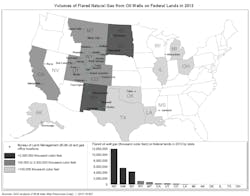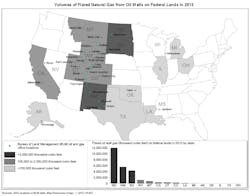GAO report criticizes DOI’s efforts for methane emissions control
US Department of the Interior reporting guidance to oil and gas operators may hinder the US Bureau of Land Management’s ability to account for methane emissions on onshore federal leases, the Government Accountability Office warned.
GAO said the agency historically has required operators to submit monthly oil and gas operations reports (OGOR) that it uses to track produced volumes, including royalty-exempt natural gas such as that vented or flared, or used to power equipment on the lease.
But this emphasis on data from royalty-bearing production provides limited guidance on how operators are to report methane emissions, GAO said in a July 21 report. Specifically, it:
• Does not provide specific instructions on how to estimate natural gas emissions, which results in operators using varying estimation methods that may be difficult to verify.
• Provides limited guidance on which OGOR categories to use when reporting flared gas emissions, which results in inconsistent reporting.
• Does not specify which natural gas emissions activities should be reported, resulting in operators not reporting some releases, such as from storage tanks.
“As a result of these limitations, Interior may not have a consistent accounting of natural gas emissions from onshore federal leases, and does not have the information it needs to reasonably ensure it is minimizing waste on these leases,” the report said.
BLM’s field offices have not consistently followed BLM’s existing guidance in managing operators’ venting or flaring requests, it said. GAO found that the field offices have approved venting or flaring requests that did not include the documentation BLM’s guidance requires, the report said.
The agency received 1,281 venting or flaring requests from operators in fiscal year 2014. GAO reviewed the documentation for a random sample of 100 of those requests and, based on this sample, estimates that 90% (+/-8) did not provide the documentation BLM guidance requires, the congressional watchdog service said in its report. “GAO also estimates that BLM approved 70% (+/-9) of these venting or flaring requests and, for nearly half of the approvals, allowed operators to flare gas royalty-free,” it added.
Investigators also found that selected BLM field offices have applied agency guidance differently to venting or flaring requests, the report said. “For example, officials in two BLM field offices GAO reviewed said they used their authority under the existing guidance to charge royalties on flared gas, while a third field office was considering doing so. The other three field offices GAO reviewed have interpreted BLM guidance as allowing all venting or flaring requests in their regions to be approved royalty-free,” it said.
GAO said BLM’s proposed update to its regulations, if finalized, would clarify how the agency will manage future venting or flaring requests. Interior officials told GAO that they expect to finalize the proposed update to its regulations by yearend and that finalizing the regulations is an Obama administration priority, the report said.
It specifically recommended that additional guidance come from:
• BLM on how to estimate gas emissions from federal oil and gas leases.
• DOI’s Office of Natural Resources Revenue (ONRR) on how to report royalty-free and royalty-bearing flaring and consider creating a separate category for royalty-bearing flaring.
• ONRR on how to report certain unreported or underreported emissions, such as emissions from storage tanks and gas vented during well completions.
• ONRR on how to differentiate between combusted and noncombusted lease use volumes reported on the OGOR, which could assist DOI in measuring its progress toward greenhouse gas reduction goals.
In a July 27 response, Kristen J. Sarri, principal deputy assistant Interior secretary for policy, management, and budget, said DOI generally concurs with the report’s recommendations.
“These findings and recommendations will enhance [BLM’s] ability to improve reporting of emissions data on the monthly [OGORs], help BLM ensure compliance with existing guidance until its proposed regulations go into effect, and ensure [ONRR] provides additional guidance on emissions data reporting,” she wrote.
Contact Nick Snow at [email protected].
About the Author

Nick Snow
NICK SNOW covered oil and gas in Washington for more than 30 years. He worked in several capacities for The Oil Daily and was founding editor of Petroleum Finance Week before joining OGJ as its Washington correspondent in September 2005 and becoming its full-time Washington editor in October 2007. He retired from OGJ in January 2020.

